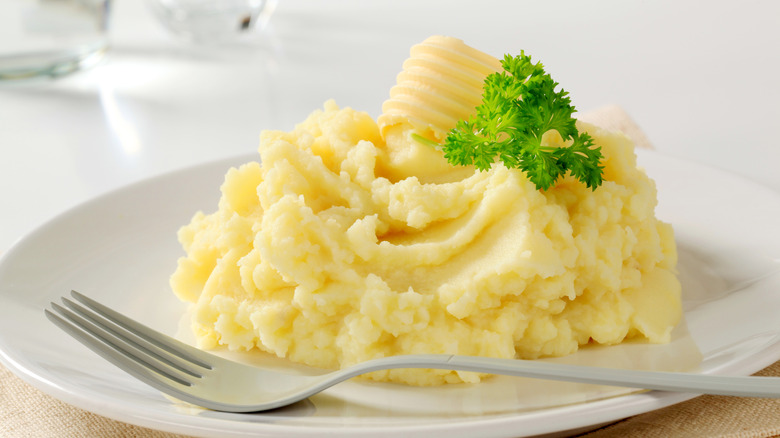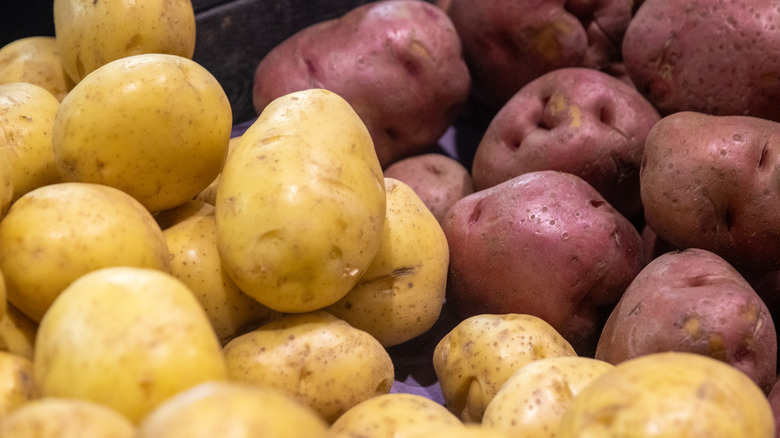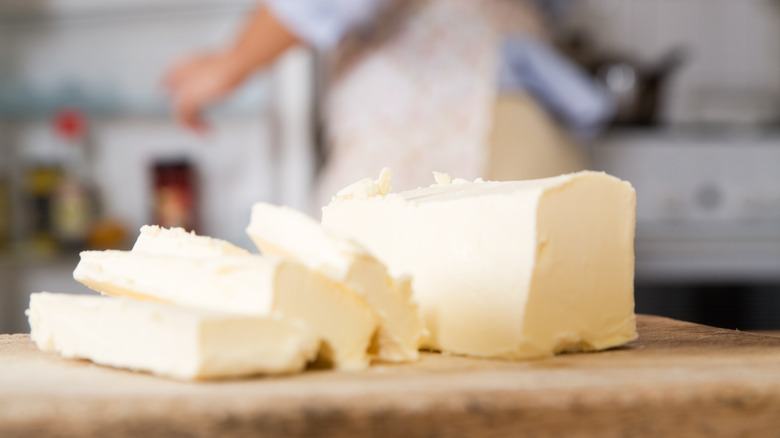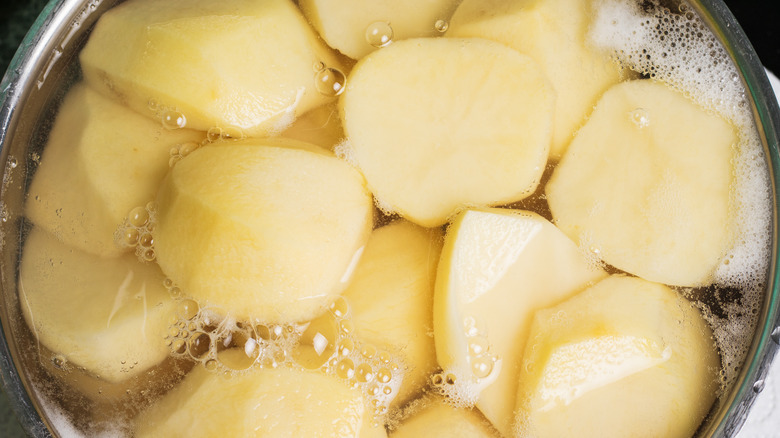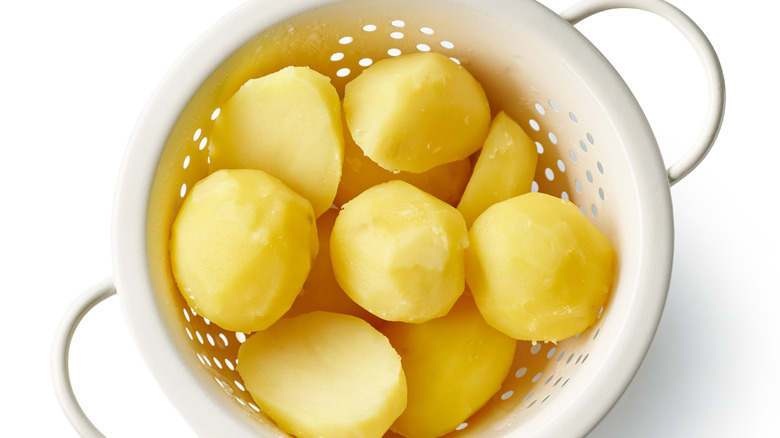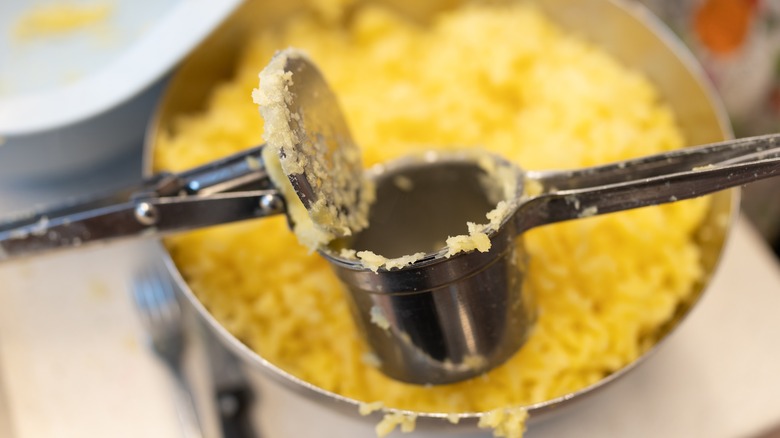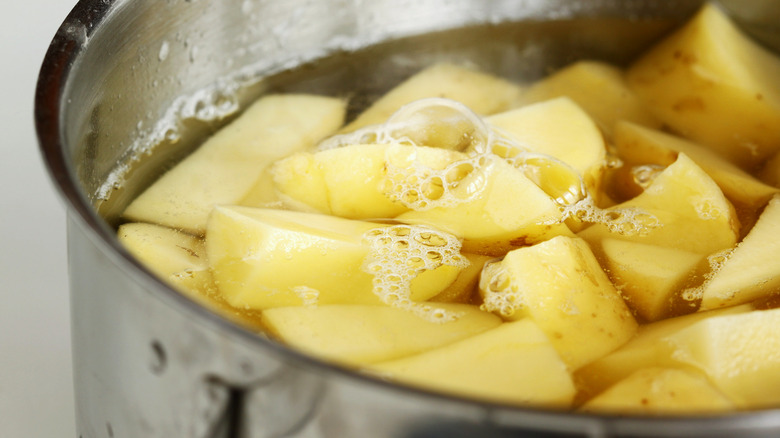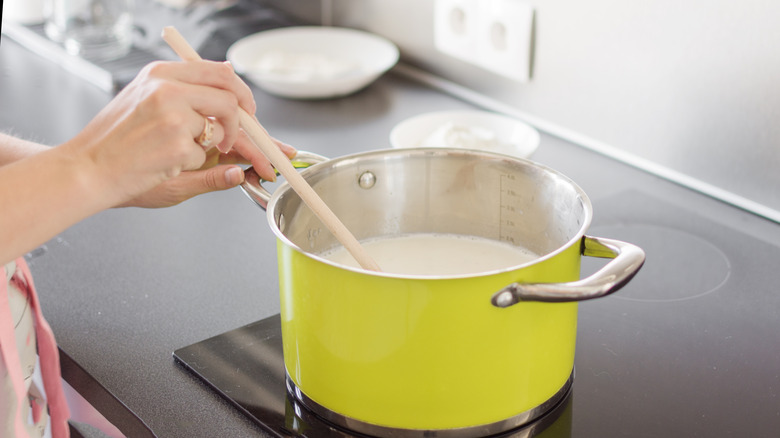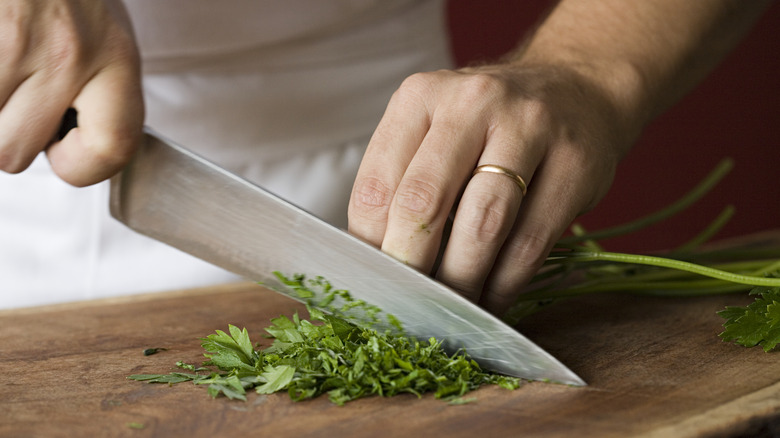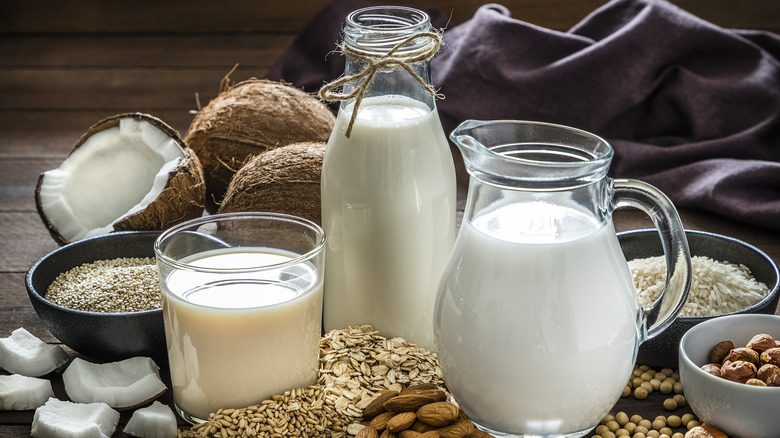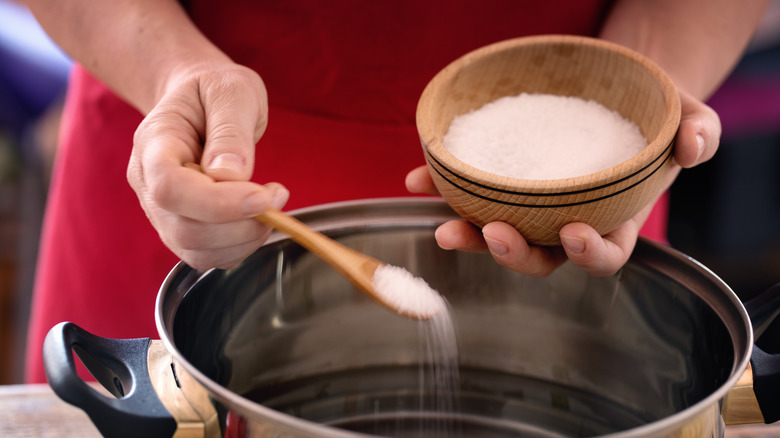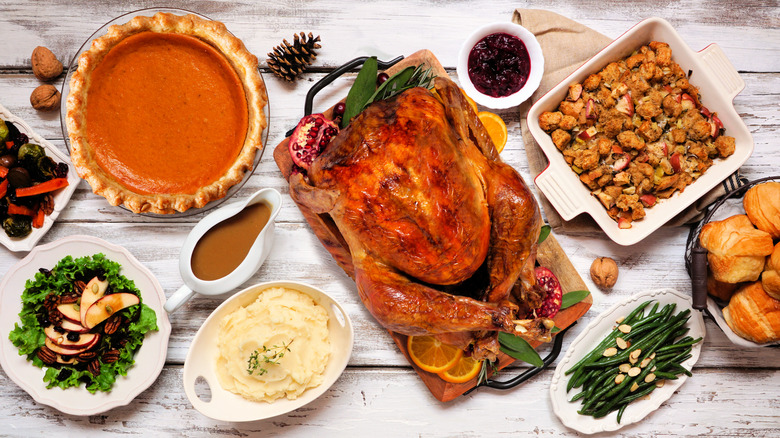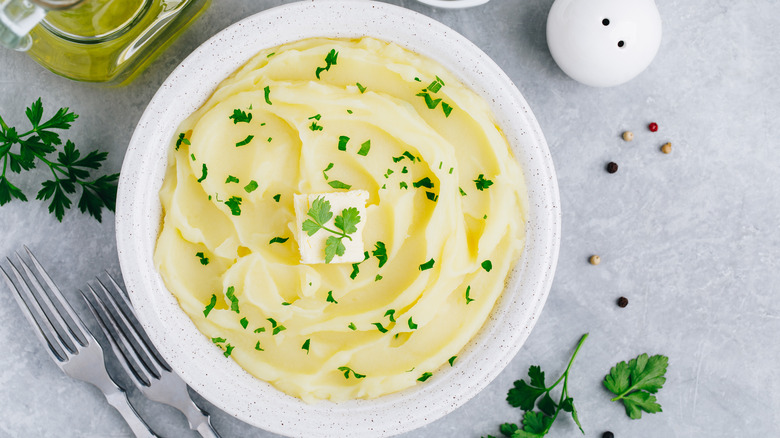13 Tips You Need For The Best Mashed Potatoes
There aren't many more disappointing things in the world of food than bad mashed potatoes. They are the cornerstone of many great dishes, but mashed potatoes are easy to get wrong. Whether they are gluey, tasteless, or runny, terrible mashed potatoes can ruin what would otherwise have been a great meal. Thankfully, you can say goodbye to ever making bad mashed potatoes again. There are many ways to improve your mash, whether adding new ingredients, choosing different cooking methods, or perfecting your preparation.
Rather than just being a sideshow to your meatballs, turkey, or slow-cooked stew, great mashed potatoes can be a wonderful star of any meal. While you do not need to apply all of these tips we have for you, you should get plenty of inspiration to take your homemade mashed potatoes to the next level and enjoy the flood of compliments on them that will pour in.
Choose your potatoes wisely
Potatoes are generally categorized into three different types, which are starchy, waxy, or all-purpose. Of those three, starchy potatoes are by far the best option for those looking to make perfectly fluffy potato mash. However, there is one big problem with starchy potatoes, which is their mild flavor. Due to this, they aren't the tastiest option, even if they do make for the greatest texture. This is why it's a great idea to mix up your potatoes by having a starchy potato combined with either a waxy or all-purpose type.
A mistake many people make is thinking that all potatoes are made equal. In the world of mash, it's far from the truth. So, what potatoes should you be using? Our recommendation would be to choose Russet potatoes as your high-starch option. A great addition to your Russets are some Yukon potatoes. These all-purpose taters have a buttery flavor while not retaining too much water. When added together in a 50/50 ratio, you get the best of both worlds, with fluffy and flavorsome mash. Feel free to experiment with different varieties to find your own perfect combination.
Butter is just as important as the potatoes
Besides potatoes, butter is going to be by far the most significant ingredient. A common mistake is adding your regular day-to-day spreadable butter or using an alternative, such as margarine. To get the best-tasting mashed potatoes, you need to use real butter. That's not all; you'll want to use the best premium-quality butter you can buy. Not all butter is created equal, and you don't want to put in all that effort mashing your potatoes just to ruin it with low-quality butter.
Another key question is whether or not you should be using salted or unsalted butter. While you can use salted butter if you're confident in getting the perfect taste, using unsalted butter will give you more control over the recipe. Using salted butter and following a recipe that calls for added salt can lead to an overload.
Instead, using unsalted butter means you can gradually add as much salt as you need until it meets your desired taste. Don't be afraid to add more butter for those looking for a creamier texture. Some professional chefs, such as Joël Robuchon, use an incredibly high 2-to-1 ratio of ½ pound of butter for every pound of potatoes.
Cut your potatoes into large, even chunks
How you cut your potatoes can have a big impact on how they cook. The temptation to cut them into small pieces is obvious. Not only will they cook faster, but they will also be easier for you to mash. It's vital to avoid this temptation.
Ideally, your potatoes should be cut to around half the size of a kiwi fruit. This size gives the perfect balance for them to cook evenly without too much water retention. With excess water, it will be almost impossible to make fluffy mashed potatoes, as too much starch will be released, leading to a gluey mixture.
A fair question here would be; why shouldn't you just boil your potatoes uncut? Firstly, this would drastically increase your cooking time, but it also makes it more difficult to ensure that your potatoes are cooked evenly.
Another crucial aspect is to have all of your potato chunks roughly the same size. Doing this means they all cook at the same rate, and you won't be left with chunks that are either over or undercooked. If you can't get your boiled potatoes right, you can always try baking them instead.
Don't over or undercook your potatoes
As with ensuring your potatoes are cut into even chunks, this tip is all about your potatoes being boiled to perfection. The exact time you should cook your spuds will depend on the size of the chunks. However, for the large chunks you should be using for mashed potatoes, the cooking time will be around 20 minutes. For those who undercook potatoes, you'll end up with crispy chunks in your mash and a bad taste, as the core of the potato will still be raw. Conversely, if you overcook your potatoes, they won't have a nice texture as the starch molecules would have broken down, leading to gooey mash.
So, how do you know when your potatoes are ready to be mashed? There are a few different methods, with the most common being to check if they are "fork tender." This is a simple test where if you can easily cut through a potato with a fork, they are ready. Another way to check is to pierce it with a knife. Once you lift the knife, the potato should stay attached to the knife briefly before dropping back into the pan. If the potato crumbles under the fork or doesn't stick to the knife at all, they are probably overcooked. This isn't the end of the world, as there are a few different ways you can rescue overcooked potatoes.
Drain thoroughly to remove excess water
For fluffy mashed potatoes, you need the starch molecules to stay intact. Without getting too technical, this is called gelatinization, and it can happen when your potatoes are exposed to heat and water. When overcooked or over-mashed, the starch molecules will break down resulting in a thick liquid; gluey mash.
One of the most important ways to prevent this gluey mash is to remove as much water as possible. One easy way to do this is by draining the potatoes properly. Initially, this is a simple step as you can place your potatoes straight from the pan and into a colander or strainer. This will remove the vast majority of the water, but some moisture will still remain on the surface of the potatoes.
This is why it's a top tip to briefly place your potatoes back into the pan. This will allow the water on the surface of the potato to evaporate away. You'll only need to do this for a couple of minutes before you can turn off the heat and allow them to stream on their own. It's important to remember that the less water on your potatoes, the greater the chance they turn into delicious fluffy mash.
Use a ricer for your mashing
As we've mentioned, there are a few ways to make your mashed potatoes gluey and one of them is over-mashing. Even though it's the quickest and easiest method, this is why you should never be tempted to use a blender. It will break down those starch molecules and, even though you'll have no lumps, the whole mixture will be very sticky. If you're the type of person who likes their mash quite lumpy, then a potato masher will give you the results you want. While that's true, many prefer to have smooth mash which still has that light texture.
For that perfect combination, a potato ricer can save the day. There are a few different types of ricers available, but they all work under the same premise of forcing the potatoes through small holes. This helps to remove any lumps without breaking down those starch molecules. Don't have a ricer to hand? Another tool that also does a fantastic job is a food mill. The manual aspect of a food mill prevents you from over-mashing as you have greater control over the process than you do with blending. Whatever method you use, it's a great idea to keep testing your mashed potatoes to ensure they aren't becoming sticky.
Start cooking your potatoes in cold water
Another important tip when boiling your potatoes is to start cooking them in cold water. This is vital to prevent uneven cooking which can lead to potatoes that have a different consistency from the outside to the inside. A common mistake that we see is getting your water to boiling point and throwing your potatoes straight in. As with many cooking methods, if you apply too much heat too early to your ingredients, the outside will cook much faster than the inside.
When you do the fork test to see if they are done, the potatoes won't cut easily, and you'll be forced to overcook the outside. As you'll know by now, this is going to lead to gluey potatoes. The correct way to boil your potatoes is to start them in cold water before applying the heat and bringing them to a boil. Once the water is boiling, you can then bring the heat down to a simmer until they are done.
Pre-warm your dairy for easy mixing
Depending on your personal preference, you'll be adding a combination of milk, cream, and butter to your cooked mashed potatoes. Whatever you're using, you'll get the best results when you warm the mixture up first. This is important for two key reasons. The first is that adding them straight from the fridge is going to instantly cool down your potatoes. This will make them stiffen and even with thorough mixing, it's hard to disguise the change in consistency it causes. This may force you to reheat your mashed potatoes which will always lead to subpar results.
The second reason is that not only will it make it easier for you to mix into the potatoes, but it will also mix more evenly. This means less work for you and better results for your mash. There are a couple of different methods of how to warm up your dairy but ideally, it should be gently heated in a double boiler. If you don't have a double boiler, then you can make your own by placing a bowl over hot water.
If your stove is full with the rest of your cooking or simply don't have the time, then you can place your dairy in a microwave. The mix will be at the right temperature after around 45 to 60 seconds but it's best to keep checking it. If that's not feasible either, then introducing the dairy at room temperature is your best bet.
Infuse flavor into the dairy
There is another good reason why you should heat up your dairy, as it gives you a great chance to infuse some beautiful flavor. When heated up, dairy has a fantastic ability to be able to pull the flavor from any ingredient you want to add. Adding these ingredients at the end doesn't allow them to mix properly and you won't get the full effect. What flavors should you add? That's entirely up to you. While there are many options, the safe choice is to go with some fresh herbs such as parsley, rosemary, sage, and basil. Not only do they taste great, but they can also help to bring some freshness and color to your dish.
Another popular choice is roasted garlic which can give you a rich, savory flavor. However, no one wants to bite into a garlic clove, and therefore straining out the solids is important before adding the dairy to your cooked potatoes. If you are making garlic mashed potatoes, then adding some parmesan cheese can help take it to the next level.
Feeling a little bolder? Adding a bit of nutmeg can bring a little spice to this traditional dish. Especially on those winter nights, nutmeg can bring depth to your mashed potatoes that will warm the heart of any guest. There are many wonderful ingredients you can add to your dairy and it's a great idea to play around with them until you find your perfect combination.
Be mindful of dietary restrictions
You've made some beautiful mashed potatoes using some of the tips above only to find that some of your guests can't eat it as they can't or don't consume dairy. Of course, this is completely understandable, but it may mean your cooking skills have gone to waste. As with making any meal, it's a wise idea beforehand to check that your guests don't have any dietary requirements that you need to consider.
Thankfully there are ways to make delicious mashed potatoes without using any dairy at all. For your milk replacement, you have a wonderful array of options depending on your preferences. Some love the creamy flavor of soy milk, others the nutty taste of almond milk, or you may even want to try the sweetness of oak milk. You can try a few different ones to see which you prefer, and you may be surprised how delicious some of these non-dairy milks can be.
Along with your choice of milk substitute, you'll also want to pick up some vegan butter. It gives you the fat you need in the form of vegetable oil and uses emulsifiers and flavorings to mimic the taste of dairy butter. This allows you to make those perfect mashed potatoes regardless of whether or not your guests can eat dairy.
Season your water with salt
Some of these tips require tools or effort, but this one is simple yet very important. If you want to add salt to your potatoes (which you should), then it's best to add it right at the start of boiling your water. This will instantly add taste to your mashed potatoes before you even add any other ingredients. The reason you want to do it at this stage is because the starch molecules will open up in the hot water and this helps to fully absorb the salt. It's for this reason that it's a great idea to add potatoes to other dishes if you fear you've over-salted your food.
If you add the salt when you're mashing the potatoes, then it won't quite have the same effect as there will be less absorption. How much salt you use will depend on your taste but it's important to remember that most of it will be drained away with the water. Due to this, up to 1 cup of salt can be used for an average pot of potatoes, but the most commonly used ratio is 1 tablespoon per pound of potatoes.
Serve quickly to avoid stiff mash
We've talked about starch gelatinization but after phenomena occurs with mashed potatoes which is starch retrogradation. In simple terms, this is when the starch molecules in the potato start to realign. In even simpler terms, the cooler your mashed potatoes get, the stiffer they become. While mashed potatoes can be reheated, they tend to lose moisture when you do this, which leads to a drier and less creamy texture. Added to that, some of the flavors can be mellowed by the reheating process, which is why it's always a good idea to serve your mashed potatoes as soon as they are ready.
The obvious difficulty here is that mashed potatoes are never alone on a dish, which means you'll be cooking something else. It's important to get your timings right to avoid any of your food being served cold. However, we sometimes get our timings wrong and when you do, a slow cooker can come to the rescue. If that's not a viable option, then other ways to keep your mash perfectly warm include a double boiler, keeping them thermally insulated, or on a stovetop with low heat and a heavy-bottomed pan. One final tip for the perfect serving of mashed potatoes is to warm up your serving bowls to prevent your mash from stiffening up when they contact with a cold surface.
Add some eye-appeal with garnish
Want to give your guests that restaurant experience? To make your mashed potatoes extra special, you can add a touch of garnish to them. Here, you add a little something on top to make them look picture-perfect and ready to be devoured. What is the little something you should add? The safe option would be to add some fresh herbs. There are many types you can use but chives, parsley, and thyme will always go down well.
On a similar note, chopped scallions or even fried shallots can be used if you want to add some mild onion flavor. Want to be a little bolder? Crispy bacon, truffle oil, or sautéed mushrooms are sure to delight your diners. Or perhaps you want to keep it traditional. If so, you can never go wrong with delicious gravy, some grated cheese, or a pat of butter. Whatever you choose, the right garnish can be the perfect finish to all your hard work.
